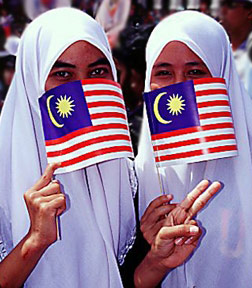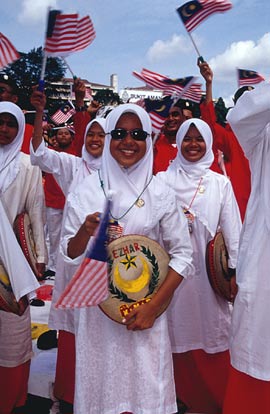 Malaysian Modesty
Malaysian Modesty |
  |
 rom a distance, a low, rhythmic rumble of drums drew the people of Kuala Lumpur to the source of the hypnotic beat. Young and old, friends and families, they streamed by the thousands into the royal heart of Malaysia's capital city. On this cool August morning in KL, the highlight of a month-long celebration was about to get under way... rom a distance, a low, rhythmic rumble of drums drew the people of Kuala Lumpur to the source of the hypnotic beat. Young and old, friends and families, they streamed by the thousands into the royal heart of Malaysia's capital city. On this cool August morning in KL, the highlight of a month-long celebration was about to get under way...
On Aug. 31 for the past 50 years, Malaysians have celebrated their independence with public expressions of pride and patriotic fervor. Merdeka (freedom) is a relatively new right in Malaysia, too fresh and long-desired by its people to be taken for granted any time soon. For centuries, the former colony in Southeast Asia was ruled by European powers that exploited its resources and controlled its strategic ports along lucrative Eastern trade routes. Then, in 1941, the people were brutally oppressed by the Japanese Army, which occupied the Malaysian Peninsula and much of the British Protectorate's island states during World War II.
|
|
| |
Today, Malaysians revel
in the independence they gained from Great Britain in 1957. From
a month-long, national celebration held in late summer to the government's
ambitious manifesto to achieve First World status by the year 2020,
Malaysia's destiny is embodied in its multi-racial population of
23 million people.
"Our independence is an auspicious occasion," said Abdullah HJ Jonid,
director general of Tourism Malaysia. "The Merdeka celebration surpasses
all other festivals. The magnitude of the event is not one day, but one month.
It marks our moving on from the Colonial Era and that we achieved self-rule without
bloodshed ... through negotiation." |
 |

Dress Parade
|
|
| |
 Malaysian Pride
Malaysian Pride |
  |
Like Times Square on New Year's Eve, July 4th and the Rose Bowl Parade all rolled into one, National Day in Malaysia is a colorful spectacle marked by joyous celebration and enthusiastic displays of nationalism. From every balcony, building facade and citizen's hand, the "Glorious Stripes" of the Jalur Gemilang, the national flag, wave with pride.
Traditionally, the Merdeka celebration begins on the eve of National Day when thousands of people crowd into Dataran Merdeka (Independence Square) in Kuala Lumpur to witness the hoisting of the Jalur Gemilang to the top of a 100-meter flagpole. The ceremonial flag-raising is accompanied by the singing of the national anthem and a spectacular fireworks display that reaches to the height of the world's tallest building, the Petronas Twin Towers. But the midnight countdown is only a prelude of events to come later that morning.
...As the sun rose on Aug. 31, the expansive pitch of Dataran Merdeka was once again filled with thousands of people, but these revelers were dressed in folkloric costumes, band uniforms and the brass and braid of elite military units. The square and surrounding streets now served as the staging area for the 12,000 participants of the National Day parade. Setting the tempo for this grand event was the 1,200-strong Malaysian Folk Drum Symphony, which beat out a captivating rhythm on ethnic Malay, Chinese, Indian and Siamese drums that reverberated throughout the federal city's Colonial Quarter. Soon, the sidewalks and reviewing stands along Jalan Raja, the royal roadway, were packed with people, dignitaries and guests who anxiously awaited the arrival of King Salahuddin Abdul Aziz Shah, and the beginning of the parade. |
|
At 8:30 a.m., when the King stepped from
his chauffeur-driven sedan, an audible silence fell over the crowd,
broken only by the sound of the Royal Guard-of-Honor snapping to attention
for the aging monarch's inspection. After reviewing the crisply uniformed
Royal Guard, the King, himself dressed in military attire, took his
honored place on the reviewing stand, which inspired an enthusiastic
response from the crowd.
"Merdeka!...Merdeka!...Merdeka!"
In unison, shouts of "Freedom!" in Malay resounded throughout the
square. Then, a formation of low-flying helicopters roared overhead, streaming
smoke in Malaysia's national colors - red, white, blue and royal yellow - signaling
the start of the three-hour parade, which promoted the theme of economic growth
and prosperity... |
 |
 Reluctant Smile
Reluctant Smile |
|
